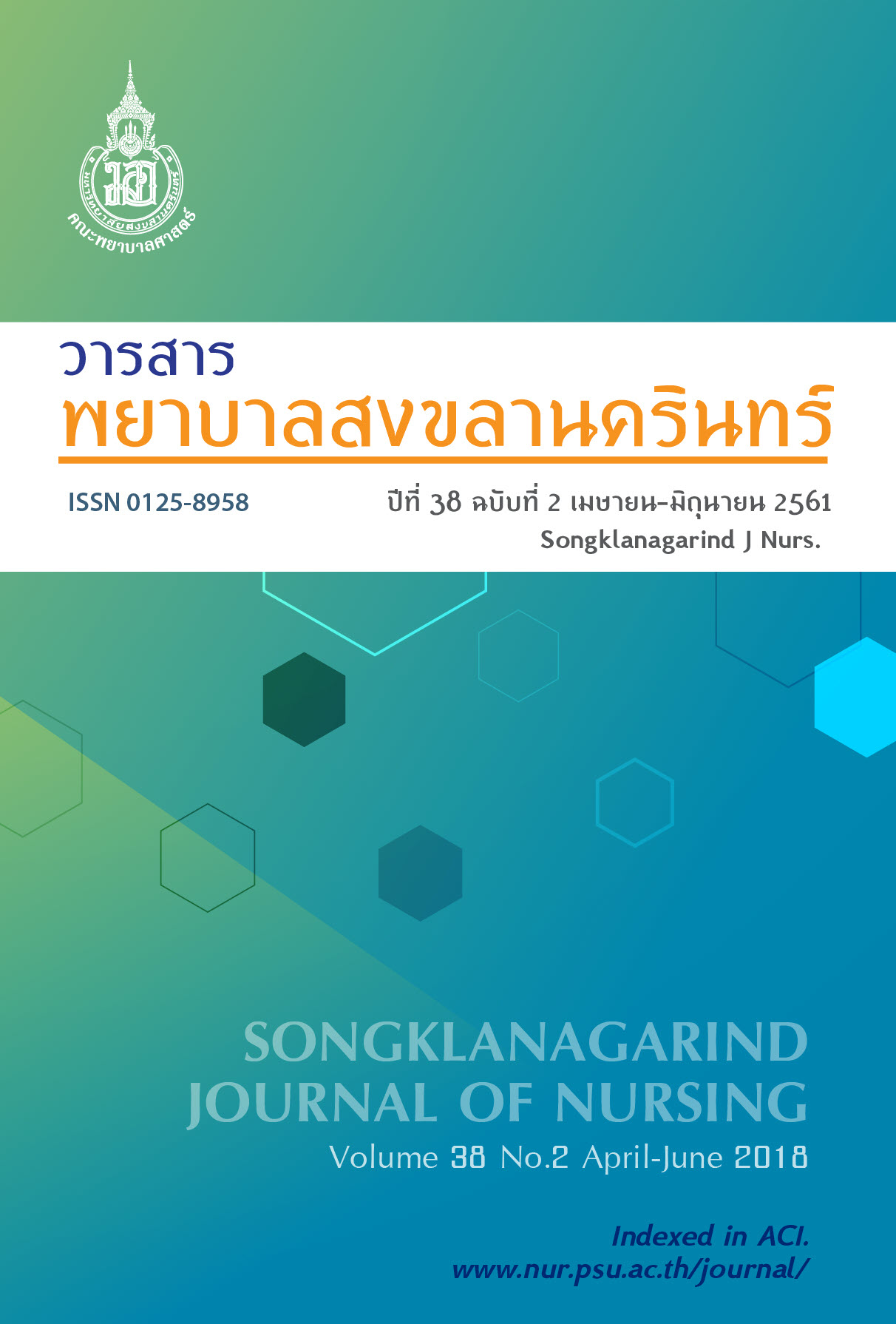Caring as Nursing: Aesthetic Expressions of Nursing Students Caring as Nursing: Aesthetic Expressions
Main Article Content
Abstract
Teaching and learning management in bachelor degree level nursing focuses on producing graduates who have a balance between science and art or aesthetic understanding of persons in order to maintain the beauty of nursing profession. This study purposed to describe the understanding of caring among nursing students through aesthetic expressions. A qualitative research method with hermeneutics based on Gardamer’sphilosophy was used. Participants comprised forty-one second year bachelor degree nursing students at Faculty of Nursing, Prince of Songkla University, Songkhla, Thailand. These students were studying Practicum of Basic Nursing Care. Data were collected between March and May, 2017 by drawing pictures with short
descriptions and interviewing to reflect on the meanings of caring. These data were analyzed by using content analysis method. This study presented findings of a major thematic category; Caring as Nursing, which consisted of three themes: 1) caring through knowledge, 2) caring through compassionate heart, and 3) caring under professional role. The findings of this study can provide guidance to nursing lecturers in developing teaching and learning strategies for undergraduate nursing students in order to create an environment that
promotes caring; including fostering and maintaining good caring behaviors in nursing students.
Article Details
References
2. Theofanidis D.Evidence Based Practice and Evidence based Nursing Education [Internet]. 2015 [cited 2018 Jun 13]. Available from: https://www. omicsonline.org/open-access/evidence-based- practice-and-evidence-based-nursing- education-2167-1168-1000279.pdf
3. Duran ET, Çetinkaya-Uslusoy E. Opinions of nursing students on the art of nursing: A qualitative study. IJCS. 2015; 8 (2): 308-16.
4. Blasdell ND. The meaning of caring in nursing practice. Int J Nurs Clin Pract. 2017; 4: 238-42. doi: 10.15344/2394-4978/2017/238
5. Salehian M, Heydari A, Moonaghi HK, et al. Developing the concept of caring in nursing education [Internet]. 2017 [cited 2018 Jun 10]. Available from: https://www.ncbi.nlm.nih.gov/pmc/ articles/PMC5498710/pdf/epj-09-4425.pdf
6. Labrague LJ, McEnroe-Petitte DM, Papathanasiou IV, et al. Nursing students’ perceptions of their own caring behaviors: A multicountry study. Int J Nurs Knowl. 2017; 28(4): 225-32. doi.org/ 10.1111/2047-3095.12108
7. Prombooth R, Amornrojanavaravutti W, Apiphatkan W, et al. The clients’ perception about caring behaviors of nursing students in clinical teaching nursing care person with health problem practicum 3 Boromarajonani College of Nursing KhonKean. Journal of Nursing and Education. 2009; 13(1): 19-25. Thai.
8 Pancharean S, Sirikul S, Caring behaviors of nursing students in clinical nursing practice. Journal of Nursing and Education. 2010; 3(3): 64-74. Thai.
9 Zamanzadeh V, Shohani M, Palmeh T. Nursing students’ perception of instructors’ caring behaviors in Tabriz University of Medical Sciences. J Caring Sci. 2015; 4(1): 55–62. doi: 10.5681/jcs.2015.006
10. Gadamer HG. Truth and method. 2nd ed. New York: Continuum; 2003.
11.Hsieh HF, Shannon SE. Three approaches to qualitative content analysis. Qual. Health Res. 2005; 15: 1277–88. doi: 10.1177/1049732305276687
12. Lincoln YS, Guba EG. Naturalistic inquiry. Beverly Hills, CA: SAGE; 1985.
13. Beck CT. Caring within nursing education: A metasynthesis. J Nurs Edu. 2001; 40(3): 101–9.
14. Milnar S. First-and third-year student nurses’ perceptions of caring behaviours. Nurs Ethics. 2001; 17(4)491–500. doi: 10.1177/0969733010 364903
15. Roach MS. Caring, the human mode of being: A blueprint for health professions. 2nd ed. Otawa: The Canadian Hospital Association; 2002.
16. Boykin A, Schoenhofer SO. Nursing as caring: A model for transforming practice. Boston: Jones and Bartlett. 2001.
17. Watson J. Jean Watson’s Theory of Human Caring. In M. E. Parker, Nursing theory and nursing practice. 2nd ed. Pheladelphia: F. A. Davis Company; 2006.
18. Pedersen B. Sivonen K. The impact of clinical encounters on student nurses’ ethical caring. Nurs Ethics. 2012; 19(6): 838-48. doi: 10.1177/09697330 12447017
19. Stacey G, Pollock K, Crawford P. A case study exploring the experience of graduate entry nursing students when learning in practice. J Adv Nurs. 2015;71(9): 2084–95. doi: 10.1111/jan.12673
20. Byrne G. Listening is a vital part of care, but how many of us have the time?. Nurs Stand. 2013; 27(51): 28-8. doi: 10.7748/ns2013.08.27.51.28.s34
21. Estrella C. Finding the time to care. Nurs Stand. 2014; 28(38): 66.


